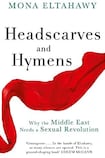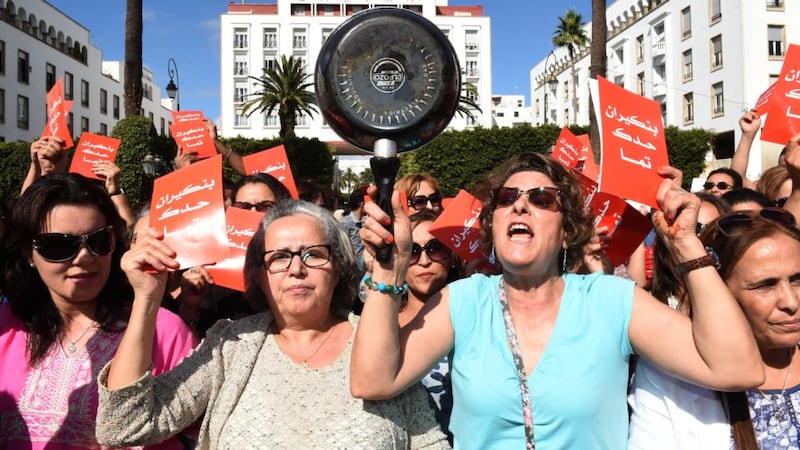
In 1982, at 15 years of age, on encountering Saudi Arabia, Mona Eltahawy was “traumatised into feminism”. (There’s many a woman in Ireland who might recount a similar emotion circa the same period.) Nothing prepared her for Saudi Arabia’s “ultra-conservative interpretation of Islam”, specifically as it applied to women. It’s hard not to broaden this, roundly, to how it applies to all human rights.
“The hatred of women is not unique to Salafism,” Eltahawy admits, asserting that a broader “Islamist hatred of women burns brightly across the region”.
Eltahawy cites that “the obsession with controlling women and our bodies often stems from the suspicion that, without restraints, women are just a few degrees short of sexual insatiability”.

There are parallels, albeit diluted ones, in Irish Catholic culture’s treatment of women and insistence on controlling their bodies. No repeal of the eighth amendment; no safe access to abortion; and many of us grew up to a non-stop indoctrination of the wicked temptation of the body and the absolute value of piety over any sexual expression. Which is to say Eltahawy can make a great deal of sense on this subject, even beyond her site-specific charges against “Islamism” in the Middle East.
The issues are complex and Eltahawy in her admirable activism and work on behalf of many silenced, oppressed and abused women can smudge the nuances of this complexity to make her argument.
In Headscarves and Hymens Eltahawy submits a litany of atrocities, abuse and the denial of basic human rights to women taking place in her part of the world. She tends to rubber band between countries with these indisputable submissions, but never really provides us with locally relevant solutions that acknowledge the specificities of these different societies.
She urges women at her lectures abroad to expose and fight local versions of misogyny to “advance the global struggle”, yet is unable to supply sufficient enlightening information, with the exception of Egypt, because she’s chosen to address such a vast geography. The book, though, could be a good primer if you knew little about the region or its women.
Courageous voice
Eltahawy’s voice is a courageous one. Her work is an accessible intercom between the West and the Middle East because she writes in English. This has the potential of being hijacked and distorted by clueless right-wing Islamophobes or being subjected to the suspicion by the very women she wishes to liberate that she writes for a Euro-American audience. This latter critique, though, does not stand up to examination, since she lives in Cairo and reserves her harshest, utterly justified criticism for Saudi Arabia, with whom the US obligingly snuggles non-stop.
Eltahawy can, therefore, find herself clobbered from all sides. Yet with the courage of her convictions – very strong convictions since this is a woman who has been sexually assaulted and so severely beaten by Egyptian security forces that both her left arm and right hand were broken – and fuelled by legitimate anger, she goes on.
Headscarves and Hymens is less a call to arms and more a protracted bellow for equality, progress and common sense. It has the hint of a manifesto, but does not ultimately coalesce to form a tangible one. The problem for Eltahawy is she wants it all achieved by noon on Monday and it's something of a one-state solution.
Most effectively in Headscarves and Hymens Eltahawy isolates, dismantles and exposes purity-piety culture, identifying its hypocrisies, its shame-pumping engine and its inexhaustible supply of self-shaming fuel within women indoctrinated by it.
She determines that purity-piety culture sinks and undermines women by the state, on the street and in the home. I’d suggest “the mind” rather than “the home”, since nothing will convince me that there are not matriarchs who are fully capable of being in-home tyrants. Eltahawy supplies personal testimony on how this purity culture has affected her, which is commendably precise, moving and disciplined in a way that underscores how passion can nix discipline in other parts of the book.
Headscarves and Hymens is an expansion of her earlier punchy and divisive essay published in Foreign Policy magazine (April 23rd, 2012) called Why Do They Hate Us? It also quotes extensively from her two-part BBC World Service radio documentary The Women of the Arab Spring. Her prose is firm and accessible rather than obtuse or academic, though there's an excess of cobbling from newspaper and human rights reports, where, in this endlessly collated, link-tweet age, more first- hand interviews or active reportage would have made for a more stimulating read.
A central consideration in the book is to probe what has happened to women post-revolution in recent uprisings, especially in Egypt and Tunisia. Whose revolution is it if women fight alongside men to get rid of a dictator, only then to find their rights still eroded by his replacement? Women can be at the barricades alongside men, but it remains to be seen if this will manifest into any platform of equality.
Likewise revolution provided a protective canopy under which sex crimes took place. Numbers are unknown in Libya due to a culture of shame and fear of family disowning for women who even admit to being raped, but in Syria, between March 2011 and July 2013, 6,000 women were raped and women continue to face “sexual violence in camps outside the country.” Post-Mubarak, under the Muslim Brotherhood, Egyptian women activists were violated by “virginity tests: rapes disguised as a medical doctor inserting his finger into the vaginal opening in search of an intact hymen.” The chapter on female genital mutilation is particularly harrowing and relentlessly disturbing.
Denounced and deconstructed
The cultural relativism of the Left is robustly denounced and deconstructed to show how we, western liberal feminists, are immune to the daily restrictions the cited women face, whilst advocating earnestly for their right to choose. (Ironic given they may actually have no choice.)
“We must not sacrifice women at the altar of political correctness, or in the name of fighting the powerful and growing right wing in countries where Muslims live as a minority.” Eltahawy urges. She describes her internal strife when she unveiled after eight years wearing hijab – “choosing to wear the hijab is much easier than choosing to take it off” – and the guilt that followed her decision. She rejects any possibility other than a ban on the niqab (the erasure and disappearance of women). She views the veil as a form of “social control” that signals “a white flag raised to signal our surrender to the Islamists and their conservatism”.
Even though she has a strong point, liberal feminists should also not patronise their Muslim sisters and dismiss all and any probability there could be circumstances where they are or would wish to make a choice other than the one imposed on them by either a dictator or a woman living three time-zones away.
Anyone who calls for prioritising women’s rights and an end to the worldwide culture that sees women murdered and raped with impunity should be heeded.
The territory the book attempts to cover and resolve is too vast so choppy dilution can result. But Eltahawy has made a very convincing case around how purity culture scuppers women and why (western) countries need to put pressure on these governments (and I include Ireland as one such government) over women’s rights.
Anakana Schofield is the author of Malarky

